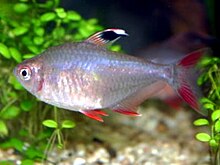

| Characiformes
Possible Cenomanian occurrence | |
|---|---|

| |
| Hyphessobrycon bentosi | |
| Scientific classification | |
| Domain: | Eukaryota |
| Kingdom: | Animalia |
| Phylum: | Chordata |
| Class: | Actinopterygii |
| (unranked): | Otophysi |
| Order: | Characiformes Regan, 1911 |
| Type species | |
| Charax gibbosus | |
| Families | |
| |
Characiformes /ˈkærəsɪfɔːrmiːz/ is an order of ray-finned fish, comprising the characins and their allies. Grouped in 18 recognized families, more than 2000 different species are described, including the well-known piranha and tetras.[1]
The Characiformes form part of a series called the Otophysi within the superorder Ostariophysi. The Otophysi contain three other orders, Cypriniformes, Siluriformes, and Gymnotiformes.[1] The Characiformes form a group known as the Characiphysi with the Siluriformes and Gymnotiformes.[2] The order Characiformes is the sister group to the orders Siluriformes and Gymnotiformes, though this has been debated in light of recent molecular evidence.[1]
Originally, the characins were all grouped within a single family, the Characidae. Since then, 18 different families have been separated out. However, classification varies somewhat, and the most recent (2011) study confirms the circumscribed Characidae as monophyletic.[3] Currently, 18 families, about 270 genera, and at least 1674 species are known.[3]
The suborder Citharinoidei, which contains the families Distichodontidae and Citharinidae, is considered the sister group to the rest of the characins, suborder Characoidei.[2] This group has a very ancient divergence from the rest of the Characiformes, dating back to the Early Cretaceous or earlier, and it has been suggested that it be better treated as its own order, the Cithariniformes.[4]
The Characiformes likely first originated and diversified on the supercontinent of West Gondwana (composed of modern Africa and South America) during the Cretaceous period, though fossils are poorly known.[1] During the Cretaceous Period, the rift between South America and Africa would be forming; this may explain the contrast in diversity between the two continents. Their low diversity in Africa may explain why some primitive fish families and the Cypriniformes coexist with them whereas they are absent in South America, where these fish may have been driven extinct.[2] The characiforms had not spread into Africa soon enough to also reach the land connection between Africa and Asia.[2] The earliest they could have spread into Central America was the late Miocene.[2]
The earliest characiform fossils date back to the Late Cretaceous, around the Santonian.[5] Other fossil teeth date back to the CenomanianofMorocco, but it has been suggested that these teeth may be of early ginglymodians.[4] Previously, the oldest characiform was assumed to be Santanichthys of the Early Cretaceous (Albian Age) of Brazil. This presumably marine taxon was used as evidence of characiformes potentially having marine origins.[6] However, more recent studies indicate that Santanaichthys is likely a basal otophysan rather than a characiform. Similarly, Salminops from Spain and Sorbinicharax from Italy, previously also considered potential marine characiforms, are now thought to have no characiform affinities and are considered indeterminate teleosts. Given this, there is no paleontological support for characiforms having marine origins.[7][8]
Uniquely, Late Cretaceous characiform fossils are found significantly north of their modern distribution. Indeterminate characiform teeth are known from the Santonian of Hungary and Maastrichtian of France, which have a large, multi-cusped appearance reminiscent of African alestids.[9] Similarly, two Campanian freshwater characiform genera, Primuluchara and Eotexachara, are known from North America, with Primuluchara having a very wide distribution across Laramidia, ranging from Texas to as far north as southern Canada (Dinosaur Park Formation). It is likely that the warmer conditions of the Late Cretaceous allowed early characins to range farther north than the present day, with African characins colonizing Europe and South American characins colonizing North America. Early characins may have had some level of salt tolerance, allowing for such colonizations to take place.[10]
Within their modern distribution, a number of modern South American characin families have their earliest occurrences in the Maastrichtian of Bolivia, with isolated teeth and skeletal elements identifiable to Acestrorhynchidae, Characidae, and Serrasalmidae.[4]
Below is a phylogeny of living Characiformes based on Betancur-Rodriguez et al. 2017[11] and Nelson, Grande & Wilson 2016.[12]
| Characiformes |
| ||||||||||||||||||||||||||||||||||||||||||||||||||||||||||||||||||||||||||||||||||||||||||||||||||||||||||||||||||||||||||||||||||||||||||
Characins possess a Weberian apparatus, a series of bony parts connecting the swim bladder and inner ear.[1] Superficially, the Characiformes somewhat resemble their relatives of the order Cypriniformes, but have a small, fleshy adipose fin between the dorsal fin and tail. Most species have teeth within the mouth, since they are often carnivorous. The body is almost always covered in well-defined scales. The mouth is also usually not truly protractile.[13]
The largest characins are Hydrocynus goliath and Salminus franciscanus and Hoplias aimara,[14] both of which are up to 1.2 m (3.9 ft). The smallest in size is about 1.7 cm (0.67 in) in the Bolivian pygmy blue characin, Xenurobrycon polyancistrus.[15] Many members are under 3 cm (1.2 in).[1]
Characins are most diverse in the Neotropics, where they are found in lakes and rivers throughout most of South and Central America. The red-bellied piranha, a member of the family Serrasalmidae within the Characiformes, is endemic to the Neotropical realm. At least 209 species of characins are found in Africa, including the distichodontids, citharinids, alestids, and hepsetids. The rest of the characins originate from the Americas.[1]
A few characins become quite large, and are important as food or game.[1] Most, however, are small shoaling fish. Many species commonly called tetras are popular in aquaria[16] because of their bright colors, general hardiness, and tolerance towards other fish in community tanks.[1]
{{cite book}}: CS1 maint: multiple names: authors list (link); Buckup P.A.: "Relationships of the Characidiinae and phylogeny of characiform fishes (Teleostei: Ostariophysi)", Phylogeny and Classification of Neotropical Fishes, L.R. Malabarba, R.E. Reis, R.P. Vari, Z.M. Lucena, eds. (Porto Alegre: Edipucr) 1998:123-144.
| Characiformes |
|
|---|---|
| Authority control databases: National |
|
|---|